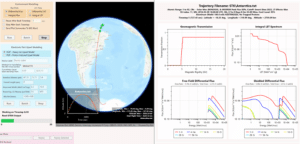Fifth Gait Technologies is attending the Applied Space Environments Conference 2025 (ASEC2025) to present on the SIRE2 family of tools. We will discuss the upcoming release of SIRE2 v2.1 and the premium products that are in developments. SIRE2-Now will provide real-time, nowcasting, and forecasting capabilities to the SIRE2 toolkit. SIRE2-Real provides historical SEP, GCR, and geomagnetic fields to calculate the environment and effects for historical mission assessment. A demonstration module for SIRE2-Real will be released alongside SIRE2 v2.1 in June 2025.
Please join us at ASEC2025 on Wednesday the 7th at 10:10am CDT to hear about our SIRE2 family of tools.

Fifth Gait Technologies and the SIRE2 Development Team recently won a NASA Phase I SBIR (https://www.nasa.gov/sbir_sttr/phase-i/). The Phase I effort is designed to provide the capability to perform system design calculations more quickly. Integrated environment and system failure calculations will allow the system designer to iterate through many radiation environment scenarios and many system designs. The new SIRE2 capabilities can be used alongside the real-time and forecasting space radiation environments to provide a new tool for mission operators. For more information, contact us at [email protected].
The Fifth Gait Technologies Neutron Test Facility (NTF) launched in September of 2023 to provide cutting edge neutron single event effects (nSEE) testing. Now in 2024, Fifth Gait is bringing online a second neutron generator, this time a deuterium-deuterium source. Fifth Gait has been at the forefront of developing the fundamental approach to nSEE evaluation for the last two decades. The NTF is a testament to our dedication to providing advanced survivability solutions and reliability testing. Contact [email protected] to book time.
Ownership of the Nuclear Clutter Infrared Simulator (NICS) chamber has been transferred from the Missile Defense Agency to Fifth Gait Technologies as of April 2024. It is located at FGT’s Colorado Springs facility, where it was recently refurbished and upgraded under a SBIR. The NICS chamber is a large, high-vacuum, cryogenic, full optical test bench with two dynamic infrared scene projectors, and a high-power quantum cascade laser. The chamber is used for both characterization of single and dual-band infrared focal plane arrays and mission emulation. Furthermore, the NICS chamber was designed with radiation testing in mind. Being portable, the system can run a mission scenario with actual radiation present.
Fifth Gait Technologies is proud to announce our infrared and visible focal plane array testing services. Our team has proven the capability to test a wide range of focal planes ranging from the latest designs featuring modern high-speed video interfaces to legacy analog systems. Fifth Gait’s custom dewar system was designed with radiation testing in mind. The system is modular, portable, and the ideal solution for the challenging environments that our customers demand. Our team has leveraged this system to perform prompt dose rate, neutron single event effects, heavy-ion single event effects, and gamma noise testing.
The recent geomagnetic storm on May 10 through May 12 had extremely elevated Kp and Dst indices (https://www.swpc.noaa.gov/news/g5-conditions-observed). While this storm gave Earth a spectacular view of the Northern Lights, it can cause havoc on satellites and space systems. At Fifth Gait Technologies, our Space Products team is developing a probabilistic Dst index model to give mission planners and operators the probability of such high Dst indices occurring during their mission and the resultant geomagnetic cutoff suppression.
Fifth Gait Technologies, Lawrence Livermore National Laboratory, and the Naval Research Laboratory develops the XTRRA cassette with support of the DoD Rapid Innovation Fund. The XTRRA cassette is now used by multiple other contractor/government teams and is becoming a standard diagnostic tool.
Fifth Gait and the Lawrence Livermore National Laboratory continue collaborating on the development of sources and diagnostics to support radiation effects experiments at the National Ignition Facility. The team deploys 3 user DIMs and performs 4 NIF shots in a single day.
The Goldflam Lab, Fifth Gait’s leading Survivability Test House, has moved to a larger location. Over the past few years, Fifth Gait has developed a solid reputation and has become a go-to test facility which allowed the Colorado Springs team to double the size of their location. The new site houses a high-tech Dynamic IR Sensor Lab, two customer labs, and a state-of-the-art ESD Test Lab.
Members of Fifth Gait’s Applied Physics and Technology Group are published in the prestigious Space Weather Journal. The Mission Specific Solar Radiation Environment Model (MSSREM) is explained in detail, as are the probabilistic modeling techniques used to design custom-built reference environments with user-specific parameters.
The Fifth Gait team that created the Space Ionizing Radiation Environment and Effects (SIRE2) toolkit has been published again in the Space Weather Journal. An overview of the capabilities in the SIRE2 Toolkit is showcased and examples of applying SIRE2 to satellite orbits and arbitrary trajectories is given.
Alongside our collaborators at SSSRC, the Space Products team at Fifth Gait Technologies is published in the Advances in Space Research journal. Our team developed an approach to transfer the Tsyganenko 1989 modulation for cutoff rigidity values to different epochs of the International Geomagnetic Reference Field. This approach enables our Space Products team to easily update the Smart-Shea 2022 geomagnetic cutoff model inside the SIRE2 tool every five years when the IGRF model is updated.
The U.S. Department of Defense Office announces that the team from Raytheon Missile Systems and Fifth Gait Technologies will receive the prestigious Nunn-Perry Award for supporting the Missile Defense Agency under the auspices of the Department of Defense Mentor-Protégé Program. The award recognizes mentor-protégé teams that have excelled in technical developments, cost effectiveness, and increased business opportunities.

